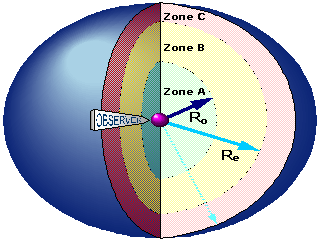
Fig. 3. (see bigger image)
3. Spatial boundaries of information interactions between agents
One of outputs of previous section is a statement that the system space is divided into the zones of strong, medium, and weak interactions between the agents of the system. It's resulted from consideration of devaluation process of information flows content during the time of their propagation through the economic system space shown in the abstract picture above.
For the clearness of the further discussion, let us introduce the notion of “observer” (it was "agent-source" above) who can be any given agent of economic system located in a certain point of its information space. This will enable us to define the differentiation between the possible interactions of each individual agent of the system (“the observer”) with all the rest of the agents. (We use the concept of the “observer” approximately in the same manner as it done in the physical Relativistic Theory by Albert Einstein). It is necessary to stress that differentiation of agent subsets considered below belonging to certain information space zones should be interpreted as a phenomenon being purely relative for the observer selected. One and the same part of economic system can be the zone of different types of interactions depending on which agent is under consideration.
Now, if the observer is located in a certain point of information space, his interactions with other agents of the system can be divided into “strong”, “medium” and “weak”.
The zone of information space in the vicinity of the observer can be considered as that of strong interactions if his information exchange with the most remote agents of this zone (positioned at its boundary) takes time that does not exceed the period during which essential changes in the system occur. Let the border of this zone be distant from the observer location point by the length of radius Ro (see Fig. 3 below). Thus, strong interactions are possible between closely positioned agents that have the opportunity of information exchange in the so-called real time mode; the subset of those agents is located inside the zone with radius Ro.
Among the agents, located at the distance more than Ro from the observer, there is a subset for which information exchange with the observer can implement their interactions provided that information flows from the source agent do not presuppose considerable feedback from the recipient agent. This case is characterized by primarily unilateral information flows; this makes it possible to increase the number of agents (compared to the group of “strong interactions”) with whom the observer can interact but has to sacrifice the feedback reactions to the signals received. Let us consider that this group of agents is in the zone of medium interactions relative to the observer. The outermost boundary of this zone is equal to the time interval of the direct travel of information flows to the point where the information substantially loses its actuality. Let this boundary be distant from the observer location by radius Re. If we assume the velocity continuity of direct and backward travel of information flows, Re should be approximately twice as long as radius Ro.
All those not included in the previous groups, and thus positioned at the distance longer than Re relative to the observer, are in the zone of weak interactions with the observer. No one from this third group of agents can have information exchange with the observer in the real time mode. During the time necessary for information flows to travel from the observer to any point in the zone of weak interactions, the content of information flows fails to be adequate to the current state of the economic system due to unexpected changes accumulated during this period. Therefore, information flows in this case cannot be the basis for full-fledged interactions; however, there are situations when, even under such circumstances, certain types of interactions do take place.
| Thus, due to technical limitations on information propagation velocity in a stochastic environment, interactions between economy participants have certain spatial structure which, in the first approximation, we characterized as zones of strong (A), medium (B), and weak (C) interactions. Interaction intensity in each of the above zones, naturally, can vary from zero to the upper possible limit for the given zone. So, all other intensities can be actually implemented in the zone of strong interactions. All the intensities can be implemented in the medium interaction zone except for the “strong intensity”, etc. |
Fig. 3. (see bigger image) |
Analogies can be easily drawn between the three levels of interaction intensity with the main types of institutional structures. Strong interactions are characteristic of "small groups" and tribes (according D. North, 1997 it is "personified links without control"); their participants can exchange information in real time. Medium interactions having mostly unilateral nature, are characteristic of hierarchy structures (D. North, 1997: "non- and personified links with control") where information flows go primarily from superiors to subordinates (from principal to agent). Weak interactions (D. North, 1997: "non-personified links without any control") correspond to market interactions.
As it was mentioned before, all the other institutional structures can work in the environment that exists in a small group. On the contrary, no other institutional structure than the market one, can function in the global market environment.
Next section - 4. General pattern of information interactions beyond theoretical limits
Previous section - 2. Theoretical limits of information interactions in economic space